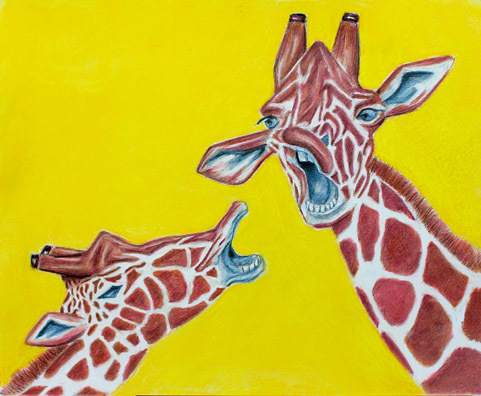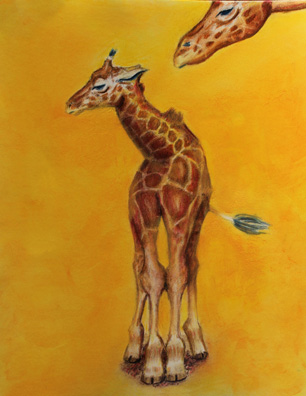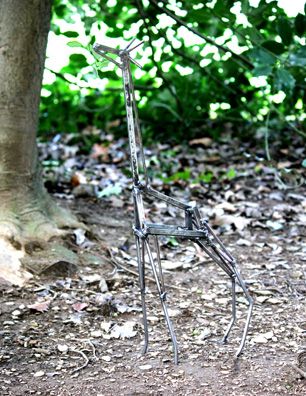Les Girafes du Monde
(Ou Tout Au Moins de l'Afrique)

Giraffes
Giraffa camelopardalis
You might think from the scientific name, Giraffa camelopardalis, that giraffes share characteristics with that ship of the desert, the camel. That is true and false. True, both animals do walk where the two legs on one side of the body both move forward at the same time. And it is also true that at a sufficient speed, both animals more or less break into a normal gallop where the legs do not move together.
But the giraffes and camels are not connected that closely on the evolutionary scale. The connection occurs only in the Order, the Artiodactylae. That is, giraffes are even-toed ungulates such as cows, sheep, goats, deer, hippopotamus, and yes, camels. But the branching from the evolutionary tree occurred back in the Miocene Period of 5 to 23 millions years ago, and none of the giraffids at that time had yet to develop the long neck.
The distinctive characteristic of the Family Giraffidae is the presence, not of a lengthy neck, but of ossicones. These are horns made of ossified cartilage that are covered with skin and fur. Today only the giraffes and their nearest relative, the okapi have ossicones. With giraffes ossicones are present on both both males and females. For the okapis, only males have the horns.
The characteristic long neck of the giraffe is not really unusual from an anatomical perspective and is a surprisingly minor variation as far as genetics go. Giraffes still have seven cervical (i. e., neck) vertebrae as do virtually all mammals. The vertebrae on a giraffe are simply larger than their shorter necked relatives.
In fact, the giraffes actually have a short neck when taken in proportion to their legs and bodies. Therefore to drink they have to take on an incredibly precarious stance which actually puts them at risk to predators. But fortunately this position doesn't have to be learned for 9 to 12 months since during that time the baby giraffes lives on its mothers milk - which is far more accessible.

Les Deux Girafes
To avoid the predators that find them a tasty treat, the giraffes use their hoofs and lash out at lightening speeds and in unexpected directions. Nonetheless, giraffes have been hunted as game - and captured live - since prehistoric times as rock drawings attest. Today even non-Africans are familiar with how the tails have had use as fly whisks among the indigenous tribes.
Now you may read that the first giraffe to appear in Europe was the one sent to Charles X of France from Mehmet Ali Pasha, the Ottoman ruler of Egypt in 1827. This is not true, and the Italian banker and politician, Lorenzo de Medici - the Grand Lorenzo, had a giraffe in his private zoo. That was in the late 1400's.
But the first clear-cut reference to a giraffe being brought to Europe was by the Roman historian Cassius Dio. In Book 23 of his Roman History he mentions there was a giraffe brought to Rome in 46 BC by none other than Julius Caesar. Not knowing what to make of such a strange animal, the Romans dubbed it a camelopardalis as it seemed to combine the neck of a camel and the spots of the leopard. The Roman name, though, is from the Greek, καμηλοπάρδαλις, which is pronounced like the Latin, kam-el-oh-PAR-da-lis. So the Greeks knew about giraffes before the Romans, which makes sense. After all, the Greeks had been ruling Egypt since the days of Alexander the Great, and certainly they must had seen giraffes.

Et Deux de Plus
It's a disturbing topic for modern readers, but giraffes were one of the many animals that wound up in the Roman arenas for the animal hunts - the venationes - performed by the bestiarii. The bestiarii are sometimes miscalled "gladiators", but true gladiators - which literally means "swordsmen" - only fought other gladiators. The bestiarii were trained in separate schools and only fought or "hunted" animals.
When you read the stories of Hercules hunting a lion in Greece or Sampson fighting a lion in the land of Israel, these accounts do indeed reflect the early demographics of the wildlife. And yes, it was the Roman games - a term we use for the Latin ludi - that so decimated the animals that hippopotamus, elephants, and - yes - giraffes, disappeared from northern Africa.
At one time giraffes ranged literally through the entire continent. The West African giraffe even roamed through what is now the Sahara Desert. There are rock paintings at Tassili n'Ajjer in central Algeria that show not only giraffes, but other wildlife now found only - and sparsely - in the savannas or more likely today, in the national parks. Said animals include elephants, hippopotamus, antelope, cattle, and yes, human beings.

Giraffe in Art
The Sahara was originally a well-watered grassland. But around 5000 BC the region began drying up, and the population, both human and animal, began migrating to regions with steady water supplies. So it's no surprise that giraffes first show up in the historical records of Ancient Egypt. The Ancient Egyptian hieroglyphic word for giraffe was written  - probably pronounced something like "mama". Another word for the beasties was
- probably pronounced something like "mama". Another word for the beasties was  which Egyptologists pronounce conventionally as "ser".
which Egyptologists pronounce conventionally as "ser".
Sadly, by the time the Nilotic civilizations were established, the giraffe was no longer indigenous to Egypt proper, and there are representations of the animals being presented as exotic or unusual gifts to the pharaoh. Hatshepsut, the Egyptian queen who later became king, had a menagerie which included a giraffe.
Although it is true that when the wildlife population declined and the Romans wiped out the remaining animals from much of North Africa, we must add that it was really the later - quote - "civilizing" - unquote - of the African continent in the nineteenth and particularly in the twentieth century that decimated the wildlife throughout the continent. Today the indigenous animals are restricted to small and often scattered regions, most of which as we said, are the national parks. So we can't blame everything on the Romans.

And More Art
And we are sure that some readers may point out that the word decimate is here being used incorrectly. "Decimate", they insist, means "to reduce by a tenth."
However, we quote the American Heritage Dictionary of the English Language:
dec.i.mate (dĕs-ə-māt')
tr.v. dec.i.mat.ed, dec.i.mat.ing, dec.i.mates
1. To destroy or kill a large part of (a group of people or organisms).
2. a. To inflict great destruction or damage on: The storm decimated the region.
b. To reduce markedly in amount: a profligate heir who decimated his trust fund.
3. To select by lot and kill one in every ten of (a group of soldiers).
And for those who know how to read, they will learn that the first definition in the American Heritage Dictionary of the English Language is the most recent and so is the current definition. The last definition is the oldest.
In other words the caudices who say that the proper use of decimate means "to reduce by a tenth" are insisting that a definition used 2000 years ago is only one we must use today.
And, of course, those nugatores will retaliate by citing the Merriam-Webster Dictionary.
dec.i.mate \dĕs-ə-māt'\ But of course we can't expect ructuoses to know that the Merriam-Webster Dictionary lists the oldest and even an obsolete definition first. Oraputides! Ructabundes! Cucurbitae! References The Giraffe : Its Biology, Behavior, and Sociology, Anne Innis Dagg, Van Nostrand Reinhold Co., 1976. Giraffes, Nicole Helget, Creative Education, 2008
"Giraffe - The Facts: Taxonomy, Evolution and Scientific Classification", Giraffe Conservation, http://www.giraffeconservation.org/giraffe_facts.php?pgid=51
dec.i.mat.ed, dec.i.mat.ing
1 : to select by lot and kill every tenth man of
2 : to exact a tax of 10 percent from
3 a : to reduce drastically especially in number
b : to cause great destruction or harm to
- dec.i.ma.tion \ dĕs-ə-mā-shən'\